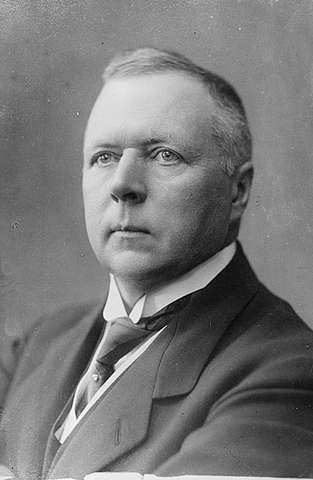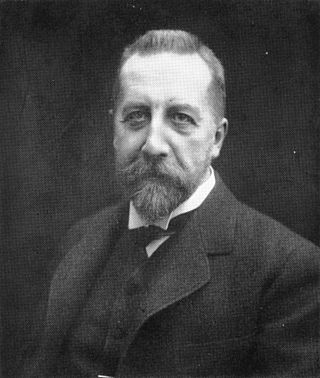
Molde Airport is an international airport serving the town of Molde, Norway. It is on the shore of the Moldefjord at Årø, 5 kilometers (3.1 mi) east of town center. The airport's catchment area covers the district of Romsdal.

The Bridle Path is a residential neighbourhood in Toronto, Ontario, Canada. It is characterized by large multimillion-dollar mansions and two to four acre lot sizes. It makes up part of Bridle Path–Sunnybrook–York Mills. Often referred to as "Millionaires' Row", as of 2014 it is the most affluent neighbourhood in Canada, with an average household income of $936,137, as well as by property values with an average dwelling value of $2.24M.
An estate is a large parcel of land under single ownership, which would historically generate income for its owner.

Johan Ludwig Mowinckel (22 October 1870 – 30 September 1943) was a Norwegian statesman, shipping magnate and philanthropist. He served as the 16th prime minister of Norway during three separate terms.

Peter Christian Hersleb Kjerschow Michelsen, better known as Christian Michelsen, was a Norwegian shipping magnate and statesman. He was the first prime minister of independent Norway and Norway's 9th prime minister from 1905 to 1907. Michelsen is most known for his central role in the dissolution of the union between Norway and Sweden in 1905, and was one of Norway's most influential politicians of his time.

Frogner Manor is a manor house and former estate in today's borough of Frogner in Oslo, Norway. The estate comprised most of the modern borough of Frogner, which has been named after the estate, and Frognerseteren with parts of the Nordmarka forest (Frognerseterskogen). The remaining part of the estate is now the site of the Frogner Park, with the manor house found in the south of the park and the Vigeland installation in the park's centre. The 18th century buildings on the grounds now house the Oslo City Museum.

Fana is a borough of the city of Bergen in Vestland county, Norway. The borough makes up the southeastern part of the municipality of Bergen. The borough was once part of the historic municipality of Fana which was incorporated into Bergen in 1972. The old municipality was much larger than the present-day borough of Fana. It also included all of the present-day boroughs of Ytrebygda and Fyllingsdalen as well as the southern part of the present-day boroughs of Årstad. As of 1 January 2012, Fana had a population of 39,216.

Bagshot Park is a royal residence located near Bagshot, a village 11 miles (18 km) south of Windsor. It is on Bagshot Heath, a 50-square-mile (130 km2) tract of formerly open land in Surrey and Berkshire. Bagshot Park occupies 51 acres (21 ha) within the designated area of Windsor Great Park.

The University of Copenhagen Botanical Garden, usually referred to simply as Copenhagen Botanical Garden, is a botanical garden located in the centre of Copenhagen, Denmark. It covers an area of 10 hectares and is particularly noted for its extensive complex of historical glasshouses dating from 1874.

Frogner Park is a public park in the central West End borough of Frogner in Oslo, Norway. The park is historically part of Frogner Manor and is Oslo's largest park, open to the public at all times. It includes the manor house which is the seat of Oslo Museum, the nearby Henriette Wegner Pavilion, the Vigeland installation of sculptures created by sculptor Gustav Vigeland, Frogner Baths, Frogner stadion, Frognerparken Café, the restaurant Herregårdskroen and the largest collection of roses in the country with 14,000 plants of 150 species. Frogner Park is the most visited tourist attraction in Norway.

The Crocker-McMillin Mansion is a historic house in Mahwah, New Jersey. It was built between 1903 and 1907 on the Darling estate for businessman George Crocker. After Crocker died in 1909, the banker Emerson McMillin lived in the 75-room, three-story residence until his death in 1922. From 1927 to 1984, the mansion was occupied by the Crocker-McMillin Mansion-Immaculate Conception Seminary. The property, located at 675 Ramapo Valley Road in Mahwah, is one of New Jersey's historical landmarks. It was listed on the National Register of Historic Places in 1997.
Lord & Burnham was a noted American boiler and greenhouse manufacturer, and builders of major public conservatories in the United States.

Damsgård Manor is a landmark manor and estate in Bergen, Norway. It is noted for its distinct rococo style and is possibly the best preserved wooden building from 18th-century Europe.

Oatlands Historic House and Gardens is an estate located in Leesburg, Virginia, United States. Oatlands is operated by the National Trust for Historic Preservation and is listed on the National Register of Historic Places as a National Historic Landmark. The Oatlands property is composed of the main mansion and 415 acres of farmland and gardens. The house is judged one of the finest Federal period country estate houses in the nation.

Belfield, also known as the Charles Willson Peale House, was the home of Charles Willson Peale from 1810 to 1826, and was declared a National Historic Landmark in 1965. The Belfield Estate was a 104-acre (42 ha) area of land in the Logan section of Philadelphia, Pennsylvania, United States, much of which is now a part of La Salle University’s campus.

Sorgenfri Palace is a royal residence of the Danish monarch, located in Lyngby-Taarbæk Municipality, on the east side of Lyngby Kongevej, in the northern suburbs of Copenhagen. The surrounding neighbourhood is called Sorgenfri after it. Only the cellar and foundations survive of the first Sorgenfri House, which was built in 1705 to design by François Dieussart. The current house was built in 1756 by Lauritz de Thurah and later adapted and extended by Peter Meyn in the 1790s. Lauritz de Thurah has also designed buildings which flank the driveway closer to the road.

Henrik Ameln was a Norwegian jurist and politician for the Conservative Party. He was a mayor of Bergen, and served five terms in the Parliament of Norway.

Rockwood Hall was a Gilded Age mansion in Mount Pleasant, New York, on the Hudson River. It was best known as the home of William Rockefeller, brother of John D. Rockefeller. Both brothers were co-founders of the Standard Oil Company. Other owners of the house or property included Alexander Slidell MacKenzie, William Henry Aspinwall, and Lloyd Aspinwall. The property was once up to 1,000 acres (400 ha) in size; the mansion at its height had 204 rooms, making it the second-largest private house in the U.S. at the time, only behind the Biltmore mansion in North Carolina. The estate is currently an 88-acre (36 ha) section of the Rockefeller State Park Preserve.

The Urdi House is a manor house in the Gyldenpris neighborhood just outside downtown Bergen, Norway. It is located at Michael Krohn Street no. 62. The house is a prime example of late Empire style architecture. The architect that designed the house is uncertain, but it has been attributed to the town surveyor Ole Peter Riis Høegh, who was active in the town between 1834 and 1848. The Urdi House received protected status in 1927.

The Helland House is a historic house in Bergen, Norway.

























